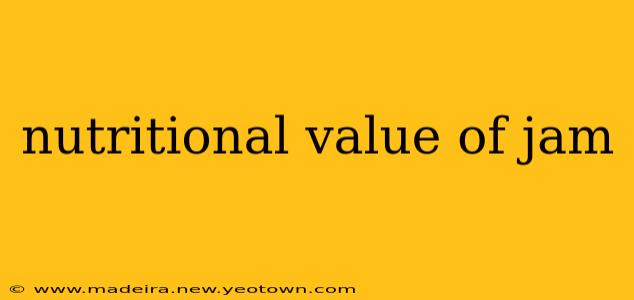Jam. That spoonful of sunshine brightening your morning toast, the sweet swirl adding a touch of elegance to your afternoon tea. But beyond its delightful taste, what's the real nutritional story behind this beloved spread? Let's delve into the sweet and sometimes surprising world of jam's nutritional value.
It's important to remember that the nutritional profile of jam varies significantly depending on the fruit used, the amount of added sugar, and any additional ingredients. A homemade strawberry jam, for example, will have a very different nutritional breakdown than a commercially produced grape jam.
What are the main nutrients in jam?
The primary nutritional components of jam typically come from the fruit itself. This means you'll find varying levels of vitamins (like vitamin C, though often reduced during processing), minerals (potassium is a common one), and fiber. However, the quantities can be quite small compared to eating the whole fruit.
Is jam healthy?
This is a complex question! The short answer is: it depends. While jam can contribute some vitamins and minerals, the high sugar content is a significant factor to consider. A diet heavy in added sugar is linked to numerous health problems, including weight gain, type 2 diabetes, and heart disease. Therefore, enjoying jam in moderation is crucial.
How much sugar is in jam?
This varies wildly, but generally speaking, jam is high in added sugar. Check the nutrition labels carefully. You'll often find that sugar is the primary ingredient, sometimes making up over half of the contents. Look for jams with lower sugar content or those made with less added sugar and more fruit.
How can I reduce the sugar content in my jam?
Many people choose to make their own jam at home to better control the sugar content. This offers a way to create a healthier version while still enjoying the delicious taste. Several recipes online guide you through making low-sugar or no-sugar-added jams using natural sweeteners like stevia or monk fruit.
What are the benefits of eating jam? (In moderation!)
Despite the high sugar content, a small amount of jam can still offer some benefits:
- Antioxidants: Some fruits used in jams contain antioxidants, which help protect your cells from damage.
- Fiber: Although the fiber content is often lower than in whole fruit, it still contributes a small amount to your daily fiber intake.
- Vitamins and Minerals: As mentioned earlier, jams offer small quantities of certain vitamins and minerals, although their concentration is often less than in fresh fruit.
Is there a healthier alternative to jam?
Absolutely! Consider these options:
- Whole Fruit: The best way to get the nutritional benefits of fruit is by eating it whole. Fruit offers fiber, vitamins, minerals, and antioxidants in significantly higher quantities compared to jam.
- Fruit Preserves with Less Sugar: Look for brands that specifically focus on reduced sugar content or use alternative sweeteners.
- Fruit Purees: These provide the flavor of fruit without the added sugar commonly found in jam.
Conclusion: Enjoy Jam Wisely
Jam can be a delicious treat, but it's vital to remember that it’s primarily a source of sugar. Enjoy it in moderation as part of a balanced diet. By making informed choices about the type of jam you consume and paying attention to portion sizes, you can enjoy the sweet taste without compromising your health.

